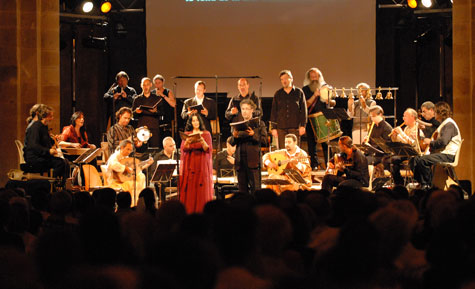
THE “JERUSALEM” ENSEMBLE Too bad more politicians aren’t musicians. |
“You are here to kneel/Where prayer has been valid.” “Here” for T.S. Eliot was a church in Huntingdonshire, but it’s hard to imagine a place where prayer has been more valid than Jerusalem, or a place where more people have died for their faith. Back in 2008, Catalan gambist and early-music superstar Jordi Savall released, on his own Alia Vox label, Jerusalem: The City of the Two Peaces: Heavenly Peace and Earthly Peace, another of his mind-boggling book/CD projects. (Predecessors include Miguel Cervantes: Don Quijote de la Mancha: Romances y Músicas, Paraísos Perdidos: Christophorus Columbus, and Francisco Javier: The Route to the Orient.) This one offered the usual two CDs (with two and a half hours’ worth of music) accompanying a 436-page book in eight languages (French, Castilian, English, Catalan, German, Italian, Hebrew, and Arabic) detailing the history of the Holy City (from the Canaanites to the Hebrews, Babylonians, Persians, Greeks, Romans, Byzantines, Arabs, Saracens, Turks, and Brits), and the three faiths — Jewish, Christian, and Muslim — that have fought over it, and the music that they’ve created, music that stitches sundered humanity back together.
And that was the program that Savall, his Hespèrion XXI and Capella Reial de Catalunya ensembles, the Palestinian Sufi troupe Al-Darwish, and guests from Israel, Armenia, Greece, and Iraq brought to Harvard’s Sanders Theatre last night, under the auspices of the Boston Early Music Festival. The last time Savall was in town, in October 2008, he offered a program of European dance music with just a handful of musicians. For “Jerusalem,” he brought most of the performers from the CDs — at one point, there were two dozen musicians playing on the Sanders stage, and that doesn’t include the 10 vocalists or the dozen shofar/anafir players.
The evening began with a fanfare Savall created for shofar (the Hebrews’ ram’s-horn trumpet, the instrument that made the walls of Jericho fall) and anafir (its long, thin, Saracen equivalent), the two groups stationed antiphonally in the Sanders balcony. In near-darkness, Montserrat Figueras sang an excerpt from the Sibylline Oracles (Jewish sources, Greek text, Aramaic music) about the imminence of the Peace of God), accompanying herself on cithara while Savall created a natural background on what looked like a rebec. Al-Darwish followed with a similarly apocalyptic passage from the Koran, Wahab Badarne singing and Usama Ghanayim Abu Ali playing the ney.
From there, the program proceeded through Jerusalem’s history as a Jewish city, a Christian city, a Muslim city, a city of pilgrimage, a city of refuge of exile, a city of hope; there were songs, there were sinuously seductive dances, there were recitations. And if the performers offered us their heritage — Yair Dalal on oud introducing Manuel Forcano’s recitation of the Talmud story of how Rabbi Akiva goes to Jerusalem; Gaguik Mouradian accompanying Razmik Amyan’s Armenian lament on kamancha — they also shared that heritage with one another, so that, as often as not, the Israeli Dalal and the Iraqi Omar Bashir would be swapping musical stories, from opposite sides of the stage, on the same instrument, the oud.